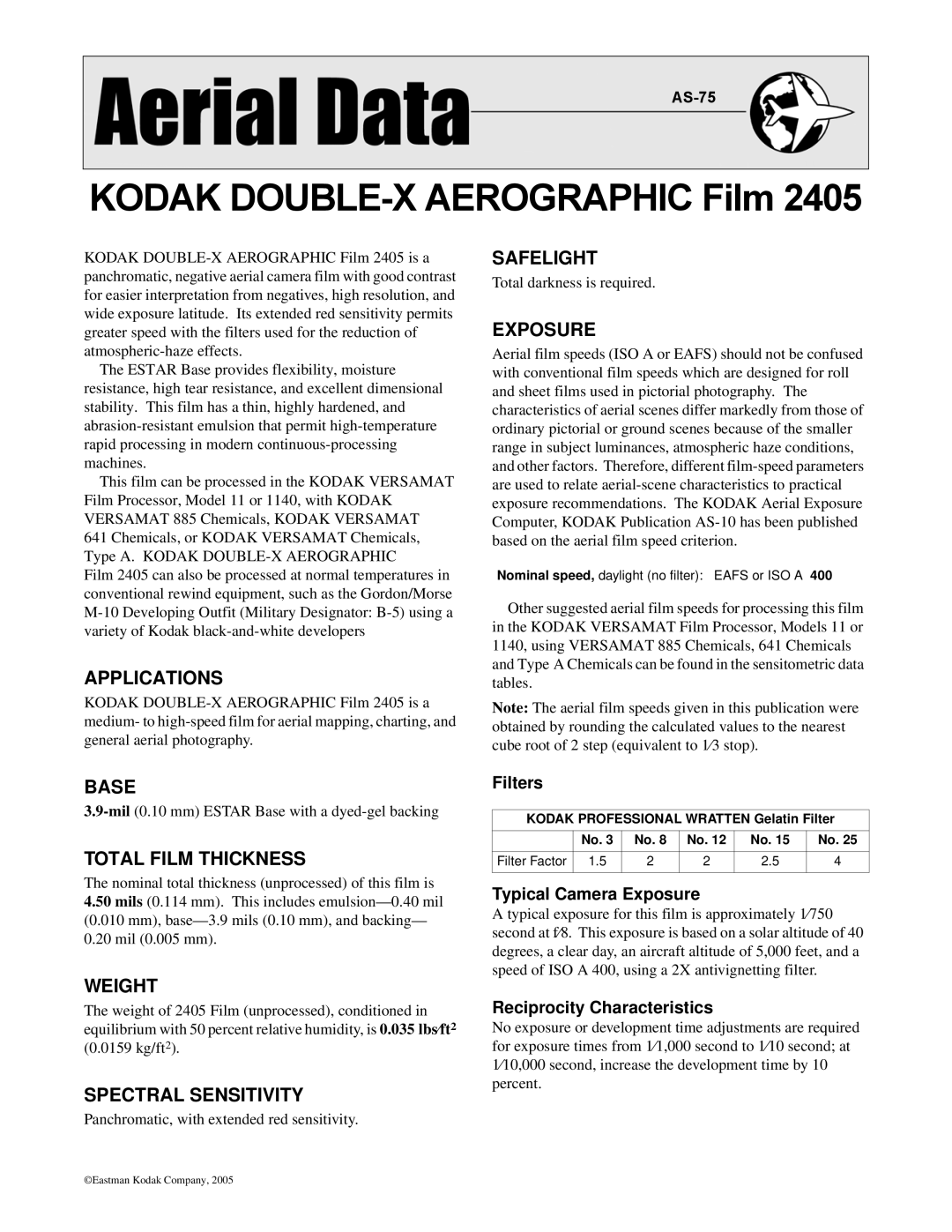
KODAK DOUBLE-X AEROGRAPHIC Film 2405
KODAK
The ESTAR Base provides flexibility, moisture resistance, high tear resistance, and excellent dimensional stability. This film has a thin, highly hardened, and
This film can be processed in the KODAK VERSAMAT Film Processor, Model 11 or 1140, with KODAK VERSAMAT 885 Chemicals, KODAK VERSAMAT
641 Chemicals, or KODAK VERSAMAT Chemicals, Type A. KODAK
Film 2405 can also be processed at normal temperatures in conventional rewind equipment, such as the Gordon/Morse
APPLICATIONS
KODAK
SAFELIGHT
Total darkness is required.
EXPOSURE
Aerial film speeds (ISO A or EAFS) should not be confused with conventional film speeds which are designed for roll and sheet films used in pictorial photography. The characteristics of aerial scenes differ markedly from those of ordinary pictorial or ground scenes because of the smaller range in subject luminances, atmospheric haze conditions, and other factors. Therefore, different
Nominal speed, daylight (no filter): EAFS or ISO A 400
Other suggested aerial film speeds for processing this film in the KODAK VERSAMAT Film Processor, Models 11 or 1140, using VERSAMAT 885 Chemicals, 641 Chemicals and Type A Chemicals can be found in the sensitometric data tables.
Note: The aerial film speeds given in this publication were obtained by rounding the calculated values to the nearest cube root of 2 step (equivalent to 1⁄3 stop).
BASE
TOTAL FILM THICKNESS
The nominal total thickness (unprocessed) of this film is
4.50mils (0.114 mm). This includes
0.20mil (0.005 mm).
WEIGHT
The weight of 2405 Film (unprocessed), conditioned in equilibrium with 50 percent relative humidity, is 0.035 lbs⁄ft2 (0.0159 kg/ft2).
SPECTRAL SENSITIVITY
Panchromatic, with extended red sensitivity.
Filters
KODAK PROFESSIONAL WRATTEN Gelatin Filter
| No. 3 | No. 8 | No. 12 | No. 15 | No. 25 |
|
|
|
|
|
|
Filter Factor | 1.5 | 2 | 2 | 2.5 | 4 |
|
|
|
|
|
|
Typical Camera Exposure
A typical exposure for this film is approximately 1⁄750 second at f⁄8. This exposure is based on a solar altitude of 40 degrees, a clear day, an aircraft altitude of 5,000 feet, and a speed of ISO A 400, using a 2X antivignetting filter.
Reciprocity Characteristics
No exposure or development time adjustments are required for exposure times from 1⁄1,000 second to 1⁄10 second; at 1⁄10,000 second, increase the development time by 10 percent.
©Eastman Kodak Company, 2005
